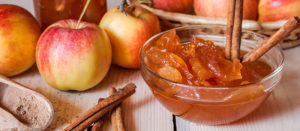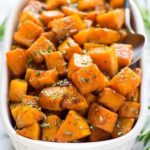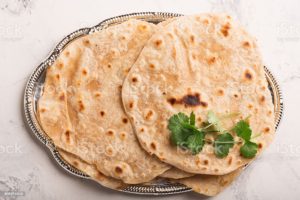Ayurvedic Recipes
(SCROLL DOWN TO THE RECIPE YOU WANT)
- Rice Pudding
- Sweet Apple Chutney
- Fresh, Homemade Almond Milk
- Baked Cinnamon Butternut Squash
- Coconut Curry Pumpkin Soup
- Brain Candy
- Raita (Cucumber Relish)
- Home-made chapati/roti
- Kitcheree
- Ayurvedic Vegetable Stir-Fry
- Okra Curry
- Ghee
- Coriander Chutney
- Steamed Basmati Rice
- Yummy Indian Yogurt Dessert (Shrikhan)
1-Rice Pudding
Builds Ojas, Balancing to Pitta & Vata
Increases Kapha. Good for cold winter days and nights
And for sexual debility (shukra dhatu)
Ingredients:
basmati rice 1/2 cup
whole milk 2 cups
water 2 cups
raisins 10 or less
ginger 1/2 to l tsp powder or 1 (or more) tsp fresh ginger root grated or chopped
nutmeg 1/8 to 1/4 tsp
cardomon l tsp decorticated or in pods, or 1-3 tsp powder
cinnamon 1/4 tsp
rock salt one pinch or more (shouldn’t taste salty)
honey to taste
Preparation
1) Put rice in large pot.
2) Rinse rice with water several times, pouring off the water.
3) To rinsed rice, add milk and water, chopped ginger root and cardomon pods or decorticated cardomon. (If your cardomon and ginger are powdered, do not add until the end of the process.) Stir.
4) Bring to boil. Keep an eye on it so the milk doesn’t boil over. Stir a few times.
5) When it comes to a boil, reduce heat to simmer. Put on lid.
6) Simmer until rice is translucent. You may need to add water if it gets too thick. It should stay soupy. Then take off the burner. (This will take around 1/2 hour to 45 minutes)
7) When cooked and taken off the burner, stir in rest of spices: nutmeg, cinnamon, cardomon (if powder), rock salt, honey to taste.
8) Serve warm or cool. (On cleansing diet it is best to eat it warm.)
Special notes:
You can adjust the spices to your taste. It should not taste strongly salty. Variations: add almonds at the end, and/or a pinch of black pepper (not on cleansing diet).
2-Sweet Apple Chutney
Sweet apple chutney is a condiment, something consumed alongside a main course. Other fruits and nuts can also be added. It reduces Pitta—you can add more ginger if you don’t want it to reduce Pitta too much). To decrease Vata, add chilis and black mustard seed fried in ghee. To increase Kapha, add almonds.
Ingredients:
2 large cooking apples quartered, peeled, cored and sliced (around 1 lb)
1 Tablespoons ginger root, peeled and minced
(or you can use 1 TBS candied ginger or 1/2 TBS ginger powder instead)
10-20 raisins
1/8 cup water
1/8 teaspoon rock salt (to taste)
1/2 teaspoons cinnamon
1 teaspoon cardomon
1/4 teaspoon clove
1/8 teaspoon nutmeg
Sweeten as needed, adding either:
for Vata reducing: 1-2 teaspoons raw sugar
for Pitta reducing – 1-2 teaspoons brown sugar
for Kapha reducing – 2-4 teaspoons honey
Preparation:
In saucepan, place sliced apples, ginger, water and salt. Bring to boil, then cover. Cook on medium/low until apples are soft (around 30 minutes). Remove from stove. Add rest of spices and sweetener. The flavor is best after 30 minutes or so.
To increase Kapha, add almonds with apples.
To decrease Vata and Kapha, in separate pan melt 1 tsp ghee and quickly fry ½ -1/2 tsp (red or green) chilis and black mustard seed and add at end.
(Adjust spice quantities to your taste.)
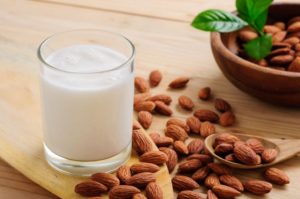 3-Fresh, Home-Made Almond Milk
3-Fresh, Home-Made Almond Milk
This is an excellent pro-ojas drink, increasing energy, strength, sexual power and stamina. It is high in easily assimilable protein and is taken in cases of general weakness and run-down feelings, and when sexual energy is low.
Directions:
At night, put 15-20 almonds (raw, not blanched or peeled) in a glass of warm water.
The next morning, at least one hour before breakfast (preferably two hours before breakfast), peel the almonds, discarding the water.
Put the peeled almonds into a blender. Add 1-2 cups of water, a pinch of cardamon and (if no inflammatory conditions or acidity is present) a peppercorn or two.
Blend for 5-8 minutes on “high,” until almonds are completely pulverized, with no paste or pieces left, a liquid consistency throughout. Add honey or brown sugar to taste and blend it briefly.
If this does not suit your normal schedule and you can’t adapt to this routine, you can take almond milk any time during the day at least 3 hours after a meal and at least 1 hour before a meal. It can be taken before bed, though first thing in the morning is best.
The almonds must be soaked for at least 8 hours. They must be whole almonds, with skins intact, NOT blanched.
If low energy is accompanied by a Pitta imbalance, add equal amount of raisins to the almonds, soak and blend them together.
This can be taken daily to increase Ojas. If you are gaining weight, you probably have enough Ojas and should think of exercising instead of drinking excessive almond milk!
4-Baked Cinnamon Butternut Squash
Ingredients
- ½ small leek, diced
- 2 Tbs. olive oil
- 1 butternut squash, cut in bite sized pieces
- ¼ tsp. cinnamon
- ½ tsp. ginger
- 1 tsp. thyme
- salt and pepper to taste
Directions
- Cook leek in olive oil in a large oven proof skillet.
- Stir in the squash and other ingredients.
- Spread the squash out in an even layer in the skillet.
Bake in the oven at 425 degrees for about 30 minutes or until squash is fork tender.
5-Coconut Curry Pumpkin Soup
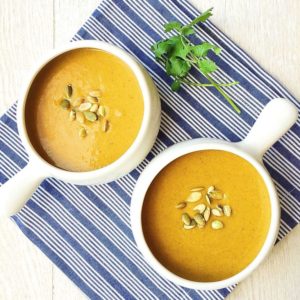
This sweet and creamy dish is Vata reducing, Pitta balancing and, depending on how much you eat, can be Kapha increasing!
Serves 6-8.
Ingredients
- 2 tablespoons ghee or olive oil
- ½ to 1 cup chopped leek or onion
- 2 inch fresh ginger, chopped
- 1 clove garlic (optional)
- 3 cups soup stock (or water)
- 2 cups cooked pumpkin or butternut squash (skin removed)
- 1 cups grated carrot
- 1 teaspoon (or cube) vegetarian bouillon
- 1/4 teaspoon turmeric
- 1 /4 teaspoon ground cinnamon
- 1 teaspoon nutmeg powder
- 1 teaspoon curry powder (or to taste)
- 1 can coconut milk (regular or light)
- Salt and pepper to taste
Directions
- Steam or bake the pumpkin or butternut squash, peel and mash.
- Heat olive oil in a large pot over medium heat. Briefly cook ginger, turmeric, curry powder (and garlic if used), then add chopped leeks, and cook until leeks are translucent.
- Add soup stock (or water), pumpkin or squash, grated carrots, bouillon, and turmeric.
- Bring to a boil and cook until carrots are tender.
- When cool, transfer to a blender and blend briefly to desired consistency. Soup is intended to be thick and creamy, so add water only if necessary.
- Return soup to pan and heat to just below boiling. Stir in coconut milk and simmer until thickens. Season with salt, pepper and add nutmeg, cinnamon and curry powder to taste.
- Serve with a sprinkle of toasted pumpkin seeds or celantro on top.
6-Brain Candy
Ingredients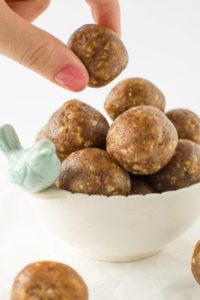
- 1 Tbs raw almonds
- 1/2 Tbs raw cashews
- 1/4 Tbs raw sesame seeds
- 1/2 Tbs dates
- 1/2 Tbs raw pumpkin seeds
- 1/2 Tbs honey (add at end to taste)
- shredded coconut (to roll in)
Directions
- Grind all together in a seed grinder or .
- Make into 1/2 inch balls and roll in shredded coconut or sesame seeds.
- Eat one or two balls twice a day.
The oils in the Brain Candy reduce Vata, increase Pitta and Kapha, making it good for the mind, for anxiety, fear, scattered mind, mental imbalances. The same qualities that reduce Vata (heavy, oily, slow, warming) also increase Pitta (heat, acidity) and Kapha (heaviness, weight, congestion) so if you have PK problems like high blood pressure, high cholesterol, skin problems, congestion, are overweight, this might not be an ideal remedy, or you can take them occasionally.
7-Raita (Cucumber Relish)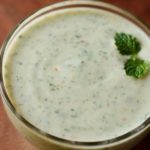
Raita is a cooling addition to a spicy meal, reducing Pitta with cucumbers and dairy. If your food is too spicy, take a little raita with each bite to cool it down.
Ingredients:
- 2 medium size cucumbers (about 1 lb.)
- 1/2 teaspoons rock salt
- 1/4 teaspoons black pepper
- 1 1/2 cups plain yoghurt (or 1 1/4 cups plain yoghurt and 1/4 cup sour cream)
- 2 Tablespoons finely chopped fresh mint
May also add:
- 1 teaspoon grated lemon or lime zest
- (2 Tablespoons avocado or sesame oil; heat in saucepan, briefly fry 1 teaspoon black mustard seeds and add at the end)
- cucumber flowers and paprika for garnishing
Directions:
- Peel cucumbers, remove seeds and slice thinly
- Mix all ingredients together.
- (Salt, pepper and mint to taste)
- The flavor is best after standing in refrigerator 30 minutes or more.
8-Homemade Chapati/ Roti (flat bread)
Warm up in Winter with easy-to-make Chapatis (also called Rotis), simple unleavened flat breads (without yeast or additives). They are not Vata-producing like bread, which has air in it from the leavening which increases Vata. Sourdough increases Vata and Pitta (sour taste). Since there is no extra gluten added for shelf life, which is in many store-bought breads, it may be digestible for those slightly gluten intolerant. Other flours can also be used, but spelt is hard to digest, corn increases Pitta. Experiment!
They are delicious with dal and vegetables; serve warm with ghee. Too many chapatis can increase Kapha and weight gain.
Ingredients:
1 cup water (as needed, may be less or more)
1 teaspoon Himalayan salt (if needed; I prefer them salt-free).
Keep a little extra flour in a shallow plate or pie dish to help with coating and dusting while rolling the chapattis
the chapatis.
Directions:
Sieve the flour, add salt to it (if you are using salt) and mix well.
Place the flour in a large bowl and add approximately ¾ cup of water. Stir lightly with fingers in a circular motion till the flour start to stick together. Add 1-2 tablespoons of more flour if the dough looks too sticky or add little more water if it looks too dry and firm. It should be firm, not dry, and not sticky.
Knead the flour until you have soft and pliable dough that does not stick to your fingers. You can put little oil on your hand while kneading the dough to help with kneading.(I prefer not adding oil to the flour this way).
Cover with plastic wrap and let the dough rest for minimum 1 hour at room temperature. If keeping for longer period store the dough in refrigerator and make sure to bring it back to room temperature before using it.
Divide the dough into 10-12 equal-sized balls. and flatten one ball at a time with help of finger tips.Transfer the flattened ball to any clean flat surface (like a cutting board) and with help of rolling pin, roll it into approx. 6-7 inch circle of uniform thickness. While rolling the chapati if the dough sticks to the rolling surface, dust it and the surface lightly with little flour. The chapatis should be very thin without any holes.
Once ready to make chapatis, heat the chapati pan or frying pan on medium-high heat. Place the flattened chapati on the hot pan and cook for 30 seconds or until tiny golden dots appear on the bottom, flip over to the other side. Once the other side is also covered with larger brown dots, turn it over again. Soon the chapati will start to puff up. With the help of a folded kitchen towel press gently on the puffed part, gently pushing the air to the flatten part of chapati until the whole chapati puffs up into a round ball (don’t get disheartened if your chapati doesn’t puff up like a ball, it will still taste as delicious as the puffed one. It may take a little practice to get perfectly puffed chapatis). You can puff up the chapati on direct flame too. Or push on the edge of the chapati with the towel, pushing the air up. If you can get the chapati to puff up, it will be better as the steam cooks
Transfer the cooked chapati’s to a plate. You can keep them for a little while in a warm oven while you cook the rest of them.
They are best served warm or hot with a bit of ghee on top.
9-Kitcheree (Mung bean or lentil stew)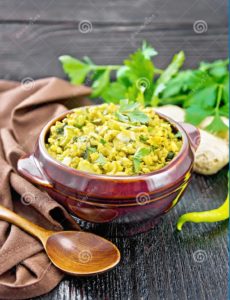
Kitcheree is an easy to digest one-dish meal consisting of a balanced protein combination of pulse, (small beans) and Basmati rice. Basmati rice is considered much easier to digest than brown rice which is why it is used in Kitcheree. The proportions of beans to rice are usually at least twice as much rice as beans, making it easy to digest. It is easy to digest, the “chicken soup” of Ayurveda, the type of food you would eat if you were recovering from an illness. For those on a cleansing diet, eating Kitcheree is a way of allowing the body to cleanse itself by increasing agni (cellular metabolic “fires”) which burn up toxins while one eliminates hard to digest, dosha-aggravating foods. During Pancha Karma, Kitcheree is the required food.
Ingredients:
1/2 Tsp. (or more) ghee
3/4 Tsp. Cumin seeds (ground cumin will do if you don’t have seeds)
1/8 Tsp. Turmeric powder
Either fresh chopped celantro or 1/2 Tsp. Coriander powder
1/2 cup Basmati Rice, washed
1/8 (or 1/4 or 1/2) cup small beans, called “dal” in India. (1/8 is easiest to digest; measure 1/4 or 1/2 cups if hunger is strong)
Choose one, either
1- Moong Dal (split mung beans), or
2-Orange Lentils, or
3-Brown Lentils
Variations:
Add 1 Tsp. grated ginger or 1/2 Tsp. dried ginger powder to increase digestive fire.
Add 1 pinch Asafoedtida (Hing) if hunger is not strong, and if Pitta is not too high. (Hing will increase P, decrease V and K. )
Directions:
Put 1/2 Teaspoon (or more) ghee in bottom of pot. Turn burner on high.
Put 3/4 Teaspoon Cumin seeds into hot ghee. When cumin seeds pop, add:
1/8Teaspoon Turmeric
1 pinch Asafoetida (Hing). (elim. for Pitta nature or imbalance)
If you don’t have fresh cilantro (which will be added later), add
1/2 Teaspoon Coriander powder.
Add 1 Teaspoon fresh grated ginger after, when adding rice and dal.
Fry spices for half a minute. Then stir in:
1/2 cup washed Basmati Rice
1/8 cup Split Mung Beans (purchased from Indian Store or Staff of Life in Santa Cruz). If you can’t get Split Mung Beans, you can use whole Mung Beans, or Orange Dahl (looks like bright orange lentils), The Mung is easiest to digest, best for weak gastric fire, for cleansing diets, and during Pancha Karma Therapy.
Stir-fry mixture briefly in ghee/spice mixture until coated.
Add two cups water (or more) and a bit of rock salt. Simmer 40 minutes or until soft (not crispy) like gruel. Or cook 12 minutes in a pressure cooker.
When done, mix in 1/3 cup (or to taste) chopped fresh cilantro. (Add small amount of Himalayan rock salt or Bragg Liquid Aminos if not tasty enough.)
Options…
- Vegetables can be cooked with the kitcheree. They are added to the mixture after spices are fried and beans and rice are stir fried and water has been added.
Important: add from one to three vegetables that harmonize, such as:
- a) sweet potato, carrot and turnip
- b) carrot and green bean
- c) sweet potato and spinach
- d) cauliflower and carrot
- e) winter squash and carrot
- f) summer squash and green beans
- g) green beans and sweet potato
- h) broccoli and carrots
- i) broccoli and sweet potato
- j) any of these vegetables alone
- Suggested vegetables:
Carrots, Broccoli, Sweet potatoes Cauliflower, broccoli, spinach (small amt., add with cilantro after mixture has been fully cooked.)
- Other spice possibilities: Use cardomon, cinnamon, cloves, fennel to make it aromatic (balancing to P and V)
Use a small amount of black mustard seeds and/or fenugreek to make it spicy (anti vata and anti kapha, pro pitta)
Use coconut to make it anti pitta, cooling.
Use chutneys and pickles for your digestion, but not on a cleansing or PK diet. Use hot or sour condiments if your gastric fire is temporarily weak and there is no general Pitta imbalance, sweet if Pitta/Vata is high, or you feel acidity or bloating; salty if appetite is missing or you are underweight. these condiments should be taken in moderation, only when needed to balance the digestive fire.
- Dal Recipe.
You can use this same recipe to make Dal, the small beans in a stew without rice
- a) Dal is made using this same recipe, eliminating rice from it. The rice can then be cooked in a separate pot.
- b) As an option, add vegetables to the dal, as above.
- c) If it is made without vegetables, the vegetables can be cooked separately (see recipe for Ayurvedic Stir Fry)
- d) It is usually served poured over rice.
- Dal Soup Recipe.
Dal Soup is made in the same way as Dal; however, instead of adding two cups of water, add three or more, depending on preference. I like it best when it contains vegetables. Rice can then be cooked separately.
10-Ayurvedic Vegetable Stir-Fry
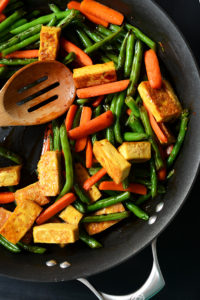
Fried vegetables are delicious, but they are bad for the heart, liver, arteries, and cholesterol. Steamed vegetables are healthy, but one misses the added flavor of oil and spices. The perfect solution is to quickly stir vegetables in ghee or olive oil with digestive spices then add water and steam them. An Ayurvedic Stir Fry is the most delicious and healthy way to eat cooked vegetables.
Choose your vegetables by season. In Winter eat root vegetables, in Summer squashes and green vegetables, in Spring and Fall make sure you add warming spices to what is local and in season.
Choosing your vegetables by imbalance: If you have a Vata imbalance, eat root and non-gassy vegetables, avoid nightshades and cabbage; if you have a Pitta imbalance avoid the spicy, salty and sour tasting vegetables like tomatoes, onions, garlic; if you have a Kapha imbalance avoid white potatoes, ice cream, heavy, oily foods.
Fried vegetablesare delicious, but they are bad for the heart, liver, arteries, and cholesterol. Steamed vegetables are healthy, but one misses the added flavor of oil and spices. The perfect solution is to quickly stir vegetables in ghee or olive oil with digestive spices then add water and steam them. An Ayurvedic Stir Fry is the most delicious and healthy way to eat cooked vegetables.
Choose your vegetables by season. In Winter eat root vegetables, in Summer squashes and green vegetables, in Spring and Fall make sure you add warming spices to what is local and in season.
Ingredients:
Oil (sesame, ghee, or olive) 1-2 tsp
Cumin seeds ½ tsp
Coriander 1/2 tsp (or 3 tsp cilantro, added at the end when vegetables still hot)
Turmeric 1/8 tsp (1 pinch)
Ginger ¼ tsp dry ginger or 1 tsp chopped fresh ginger
Chopped Vegetables 1-3 cups (see Ayurvedic diet lists in Cynthia’s book Know Your Blueprint)
Water to cover vegetables halfway
Himalayan rock salt to taste (should not taste too salty)
Instructions:
Cut up vegetables and ginger
Heat oil in a frying pan or wok
Add cumin seeds to hot oil frying them for 30 seconds until they pop, then add powdered spices and stir briefly, to coat them
Add cut vegetables and fresh ginger and stir-fry quickly to coat vegetables
When coated, immedately add water to 1/2 height of vegetables, cover with lid
Reduce heat to simmer. Stir occassionally. They are done when they can be cut with a fork
If you are using cilantro instead of powdered coriander, add when vegetables are done and still hot.
When ready to serve, season with Bragg liquid Aminos or Himalayan Rock Salt to taste
Be sure to pour the leftover liquid “gravy”on the vegetables or sip the liquid with the meal; lots of minerals are in that stir-fry water!
11-Okra Curry (Stir Fry)
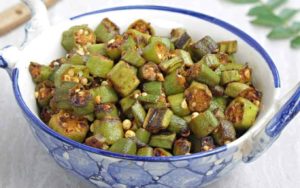
Okra is a vegetable that is alkalinizing, builds bone, and reduces Pitta (inflammation). It is especially good for reducing dryness in the joints, as in arthritis. It builds ojas (immunity). It is cooling, slimy and astringent. It is tri-doshic. To reduce the slimy quality you can cut the pods lengthwise, put them face down on a cookie sheet and roast them in the oven. This recipe keeps the sliminess, which is good to counter dryness in the bones.
Ingredients:
Oil (sesame, ghee, or olive) 1 tsp
Cumin seeds 1/2 tsp.
Coriander powder 1/2 tsp.(Or add ¼ cup chopped cilantro at the end)
Turmeric powder 1/8 tsp. (1 pinch)
Chopped okra. 1 cup washed and sliced vertically into 1/3 inch round pieces.
Ginger. You can add 1/4 tsp. dry ginger with spices or add 1/8 cup chopped fresh ginger when you add the okra or the water.
Directions:
Heat the oil in a frying pan, heavy bottomed is best, like cast iron.
Add dry spices to the hot oil, frying them for about 30 seconds.
Add okra and stir fry quickly to coat vegetables
Add water to 1/2 height of vegetables, cover. Turn down the heat until liquid simmers. Okra will be steaming in the liquid. They are done when they can be cut with a fork. Not mushy and not al dente. Around 5-10 minutes usually.
When done, take off the hot burner and add chopped cilantro (if have not used coriander powder initially).
Add Bragg liquid Aminos or Himalayan Rock Salt to taste
You can add 1/4 tsp. dry ginger with spices or add fresh ginger with vegetables or with water. Eat Okra Stir Fry with Steamed Basmati Rice.
12-Ghee 
Ingredients:
1-2 pounds of raw, unsalted, organic butter.
Process:
Place butter in a heavy pot at low heat.
The butter will melt and the milk solids (white) will come to the top.
Periodically skim off the milk solids and discard, or wait until the end of the process when they sink and the ghee can be poured off.
Eventually the boiling will decrease to tiny bubbles. The water must be totally boiled off. How to determine that moment, before it burns? One technique is to wait until it stops bubbling; another is to drop a drop of water on the ghee and see if it sinks (not done) or skips (done).
When it is done, immediately take it off the burner. If it cooks too long, it turns caramel color and tastes odd. It is said that it is not harmful to eat, but it does not taste like ghee. (It is burnt.)
Allow it to sit for 30 minutes so that any remaining milk solids fall to the bottom of the pot. Then pour the clear yellow liquid into a glass container, pouring it through cheesecloth to capture the milk solids that have dropped to the bottom of the pot.
If any clear water remains at the top, you can re-cook it to remove that water, or put it in the refrigerator and use soon. If all water is removed, ghee will last unrefrigerated for 100 years. Old ghee is said to have strong healing properties.
Another technique is to transfer the ghee to a new pot before it is completely done. That way you leave the milk solids in the bottom of the first pan, and the ghee in the second pan is less likely to burn. In the second pot, you boil off the remaining water.
Ghee is the best remedy for disturbances of the Passionate Blueprint, inflammatory problems. Many Ayurvedic herbal remedies are taken with ghee, as it takes the herbs directly to the liver. It does not increase cholesterol the way butter does, according to Ayurveda. It is high in protein and is taken with milk to increase vital energy reserves called Ojas (a concept similar to the Immune System.)
13-Coriander Chutney
Coriander chutney is an Indian condiment, something to put on the table as we might use Ketchup. It is a good way to spice up your dal or kitcheree. In summer, or when your Pitta is too high, you can add coconut flakes and eliminate cayenne to reduce the heating quality. Cilantro is cooling, cumin is a digestive and ginger is heating (also digestive). Cayenne makes it highly anti-Vata and Kapha, and adding coconut makes it anti Pitta and can increase Kapha. Try adding small amounts of the spices, tasting the result and making this chutney to your taste!
Ingredients:
2 cups chopped green coriander
1 tsp cayenne pepper (or ¼ tsp black pepper and 2 TBS fresh chopped ginger root)
(1 TBS ground coconut flakes)
1 tsp Himalayan salt
1 tsp dry roasted cumin seeds, powdered
1 TBS lemon juice (or to taste)
½ cup water
Instructions:
(To roast cumin seeds, put them in a frying pan (preferably cast iron) on a hot burner and stir periodically until they turn slightly darker. Then grind into a powder in a seed/coffee grinder.)
Mix all ingredients together and grind in a blender. Then add water and blend more.
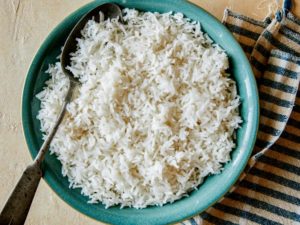 14-Basmati Rice
14-Basmati Rice
Ingredients: ( ¼ cup per person)
½ cup Basmati Rice (Aged, preferably long grained, not parboiled). Aged basmati rice is much easier to digest than new rice. If it doesn’t say “Aged” then it is new.
1 cup filtered water (double the amount of rice)
Timer
Instructions:
Wash rice.
Put rice into a saucepan and cover it with water to a few inches above the rice. Swish it around in the water a few seconds before pouring the water off. Repeat three times or until water is clear (white starchy part washed off).
Add filtered water to rice in pan. There should be twice as much water as rice. You can use a measuring cup (1 cup water to ½ cup rice). Another way to measure the water is to put your finger in the pan as a measure. The water above the rice should be the same height above the as the height of the rice from the bottom of the pan.
Turn a stove burner on high and put the pan with rice and water, with the top off, on a burner. Stir once after a few minutes. When it starts to boil, turn burner down to very low. Set the timer at 15 minutes and start it when the water begins to boil.
Keep the top off until the rice is simmering then put the top on the pan.
When the timer goes off, turn off the burner and let the rice continue to absorb water for 5 minutes or more.
Fluff it up with a fork or large curved spoon and serve.
Steaming basmati rice in the oven.
Another way to make basmati rice, especially when you want to make a big batch, is to preheat your oven to 350 degrees. Wash rice as above then put it in a big stainless steel rectangular pan with twice the water (measured as above). Cover tightly with tinfoil. Put in preheated oven for 30 minutes, check to see if soft/done and take out of the oven. Let it sit for 5 minutes, then fluff up and serve.
 15-Yummy Indian Yogurt Dessert (Shrikhan)
15-Yummy Indian Yogurt Dessert (Shrikhan)
This sweetened, condensed yogurt dessert is delicious served cold on a hot summer day. It looks and tastes like a healthy ice cream, tasty, sweet and a little sour. I like the simple version with an abundance of cardamon and honey to taste.
Ingredients:
4 cups yogurt (Pavel’s Russian yogurt/mild original or Greek yogurt or any full fat plain unsweetened yogurt)
½ cup honey or brown sugar (can add more or less, to your taste)
Dash of cinnamon powder
Pinch of nutmeg
Dash of black pepper
1 Tsp or more cardamon powder
To make it richer, you can also add:
2 TBS blanched, sliced almonds
A few sliced pistachios
½ cup raisins
½ Tsp saffron
Instructions:
Put cheesecloth over a colander and place over a deep plate. Place yogurt on the cheesecloth in the colander. The whey will drip out in 1-3 hours. When most of the whey liquid has dripped out, squeeze the cheesecloth. (You can use the whey for other things or can throw it away.) If your kitchen is hot you can put it in the refrigerator to condense.
Take the condensed yogurt out of the cheesecloth and put into a large bowl. Add the rest of the ingredients and stir. Serve cold in small bowls. Can put the sliced nuts on top of each bowl as a garnish. Add spices to taste. I like a lot of cardamon and nutmeg and I leave out the pepper.



